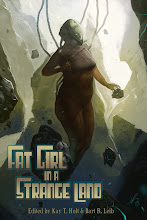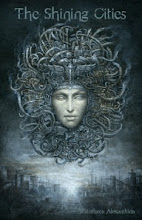Creating fully realized characters is perhaps one of the biggest difficulties I have while writing. Most of my ideas start from some imagistic scene that appears in my mind’s eye. Sometimes it’s even snatches of dialogue that stick in my ear like a catchy pop song until I give in and write about it. But what is absent is character. All I usually have are hazy impressions, maybe a suggestion of relationships or context fueling the scenario, but nothing more.
I’m no writing god – my works don’t spring fully formed out of my forehead.
My first novel started out with a scene in a hayloft between my romantic leads. I didn’t know any particulars – the who, what, where, when, and why. But I knew I wanted to render what was so vividly in my head into words. Constructing a story around that scene was more difficult than I expected. First I had to figure out just who my characters were. By that I mean their circumstances – the individual personality traits had yet to reveal themselves. And that required research since it became clear that my story could only be set in the medieval past.
Then once I had a stronger sense of who my characters were – a landless Norman knight and an Anglo-Saxon noblewoman – I had to figure out how to craft a story around the moment in the hayloft – it wasn’t a scene strong enough for a beginning or ending, so I would need to create those as well. In plotting my story, I created character backstories that explained their respective situations at the start of Chapter One. Those backstories were hugely useful for identifying character motivations and determining their choices over the course of the rest of the novel.
When I finished my first draft – a feat in and of itself – I wondered if I knew my characters well enough. I knew what they looked like, I knew how they would behave in dramatic situations, their mannerisms, the cadence to their voices… but did I make that clear to the reader? Did I provide enough telling details so the reader would get the same visceral impressions I get whenever I visualize scenes from my novel? And did they not just see my characters but identify with them, feel what they feel over the course of the story, highs and lows, and all that?
Perhaps it is because I know character was one of the last aspects that fell into place for me in the writing and revising of the story that I am so sensitive to its success. Now that I have revised my story for the umpteenth time, and written a few more along the way, I am at a place where I can look back at this first novel and more objectively evaluate it. Of course there were a couple of novice writer issues that I have since fixed, but it is one of the most fully conceptualized works I have written, and although I may tweak it time and again in between deciding the next steps I need to take for getting it published, I am pleased with how it turned out, characters and all.
Character is still one of the last pieces that falls into place for me. But I try not to let that deter me from working through that oh-so-important first draft. And here are the steps I rely on to keep writing:
Write that first inspirational scene – I force myself to write whatever it is that serves as the kernel of my story, and in the course of capturing the scene or conversation, I pull in other details, usually those I wasn’t even consciously aware of. I don’t worry too much about my lack of character awareness at this stage. But any personality traits or hints of backstory that I do bring in at this stage are instinctual and often hugely influential at later stages. This scene may not be a keystone for the story structurally, but it is the keystone for the story’s development.
Figure out how that key scene fits into the larger story – This takes a long time, lots of thought, and for me, lots of research. I would not call myself a bona fide plotter, but I do like having an idea of where I am going when I am writing. And one of the things I like to identify early on is the beginning of my story.
Link the beginning of the story to the key scene – This way I can write the beginning and keep writing until I link it to the scene I’ve already roughed out. At this point I start thinking about my character backstories and what brings them to the start of the story, but there are still a number of blanks that I just have to accept and move on – otherwise I risk bringing my momentum to a halt. Usually by the time I have connected the beginning to the keystone scene, I have lived in my characters’ heads for long enough that I have a stronger sense of who they are and where they are going.
Finish the rest of the story – Completing the first draft of any story as quickly as possible is common advice, and I try to follow it to the best of my ability. Character traits may still be emergent, more details more clearly articulated, at this stage, but my goal is to finish the story first and foremost.
Determine character arc over the course of the story – This is where I pause, read over everything, and try to see what the combination of characters’ description, dialogue, and choices tells me about them. Are there inconsistencies from where I started and where I ended? Does this signal character growth or traits I need to revise for consistency? Are there places where I need to include more/less backstory to justify behaviors? Are there places, particularly in the beginning, that I need to make my characters’ actions and behaviors more clearly defined?
Refine, refine, refine – Here I address other manuscript issues in addition to character development: smoothing out scenes, ratcheting up transitions, sharpening dialogue, polishing description, etc. Changes at this point are to strengthen character or action while eliminating sluggish phrasing and grammatical errors.
I am a firm believer that even if you don’t know your characters very well at the start of a story, it is ok because by the end of the first draft, you will have a clearer, more intimate understanding. As long as you keep writing, the characters will emerge out of an accumulation of choices, reactions, mannerisms, and dialogue. You may need to scour your manuscript for consistency in the end, but not knowing your character initially is no reason to not write your story.
You will find you know more about them than you thought you did.
Subscribe to:
Post Comments (Atom)










3 comments:
Great post! I really like how you go about writing your first draft. I do a more plotting in the beginning, but even with an outline I don't always know my characters completely until I start writing. So many things change once my writing momentum kicks in! Sometimes it's hard to relinquish control when I have something very specific in mind, but it's good to let the story go its natural way instead of forcing it along.
For me, it's a balance thing. I don't want to risk constraining my story by over planning, but at the same time, unless I have a goal of some sort for the scene at hand, the story overall, I have nothing to work towards.
I usually plot, but lately have been allowing my characters to move the plot. Have you ever tried a character chart? Sometimes as you're filling on in, you realize points in your work where you can make certain traits apparent.
Post a Comment